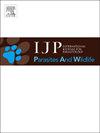Enumerating genotypic diversity and host specificity of Giardia in wild rodents around a New York watershed
IF 2
3区 医学
Q3 ECOLOGY
International Journal for Parasitology-Parasites and Wildlife
Pub Date : 2024-09-19
DOI:10.1016/j.ijppaw.2024.100995
引用次数: 0
Abstract
Giardia is a genus of flagellated protozoans that parasitize the gastrointestinal tract of humans and wildlife worldwide. While G. duodenalis is well-studied due to its potential to cause outbreaks of diarrheal illness in humans, other Giardia species from wildlife have been largely understudied. This study examines the occurrence, host specificity, and genotypic diversity of Giardia in wild rodents living within the New York City water supply watershed. A novel nested PCR assay targeting the 18S ssu-rDNA gene is introduced, which captures nearly the entire gene for improved species-level determination versus existing molecular typing methods. Molecular characterization of 55 Giardia specimens reveals at least seven novel lineages. Phylogenetic analysis indicates a close relationship between the newly characterized Giardia lineages and rodent hosts, suggesting rodents as important reservoirs of Giardia and its close relatives. These findings provide insights into the diversity of Giardia species and their public health potential in localities with human-wildlife interaction and further emphasizes the need for continued efforts to improve the molecular tools used to study microbial eukaryotes, especially those with zoonotic potential.

列举纽约流域野生啮齿动物中贾第虫的基因型多样性和宿主特异性
贾第虫是一种鞭毛原生动物,寄生在世界各地的人类和野生动物的胃肠道中。由于杜氏贾第鞭毛虫有可能导致人类腹泻疾病的爆发,因此对其进行了深入研究,但对野生动物中的其他贾第虫种类却大多研究不足。本研究考察了生活在纽约市供水流域的野生啮齿动物中贾第虫的发生、宿主特异性和基因型多样性。研究引入了一种针对 18S ssu-rDNA 基因的新型巢式 PCR 检测方法,与现有的分子分型方法相比,该方法几乎能捕捉到整个基因,从而提高了物种水平的判定能力。对 55 份贾第鞭毛虫标本进行分子鉴定后,发现至少有 7 个新的品系。系统发生学分析表明,新表征的贾第鞭毛虫系与啮齿动物宿主关系密切,表明啮齿动物是贾第鞭毛虫及其近亲的重要贮藏地。这些发现使人们深入了解了贾第鞭毛虫物种的多样性及其在人类与野生动物互动地区的公共卫生潜力,并进一步强调了继续努力改进用于研究微生物真核生物,特别是具有人畜共患病潜力的微生物真核生物的分子工具的必要性。
本文章由计算机程序翻译,如有差异,请以英文原文为准。
求助全文
约1分钟内获得全文
求助全文
来源期刊

International Journal for Parasitology-Parasites and Wildlife
Medicine-Infectious Diseases
CiteScore
3.80
自引率
5.60%
发文量
113
审稿时长
45 days
期刊介绍:
The International Journal for Parasitology: Parasites and Wildlife (IJP-PAW) publishes the results of original research on parasites of all wildlife, invertebrate and vertebrate. This includes free-ranging, wild populations, as well as captive wildlife, semi-domesticated species (e.g. reindeer) and farmed populations of recently domesticated or wild-captured species (e.g. cultured fishes). Articles on all aspects of wildlife parasitology are welcomed including taxonomy, biodiversity and distribution, ecology and epidemiology, population biology and host-parasite relationships. The impact of parasites on the health and conservation of wildlife is seen as an important area covered by the journal especially the potential role of environmental factors, for example climate. Also important to the journal is ''one health'' and the nature of interactions between wildlife, people and domestic animals, including disease emergence and zoonoses.
 求助内容:
求助内容: 应助结果提醒方式:
应助结果提醒方式:


